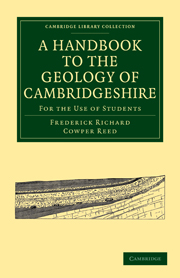THE JURASSIC BEDS
Published online by Cambridge University Press: 05 July 2011
Summary
General remarks. The members of the Jurassic System which are found in this area occupy only its northern and north-western portion, with the exception of the Upware inlier. In the immediately adjoining counties of Bedford and Huntingdon there are, however, several sections of interest which are readily accessible; and in order to give a clear idea of the relations, etc. of the beds it will be necessary briefly to refer to them.
The only portions of the Jurassic System which occur in Cambridgeshire belong to the Middle and Upper Oolites, from the Oxford Clay to the Kimeridge Clay inclusive.
One of the features of the series in this part of England is the absence of the typical calcareous development of the Corallian to which we are accustomed in the south-western counties and in Yorkshire. In Bedfordshire, Cambridgeshire, and Lincolnshire there is an almost unbroken succession of clays from the Oxford Clay to the Kimeridge Clay. Some subsidiary and thin limestone bands are indeed intercalated, and the Upware Corallian limestone reef has long been famous, but practically the Jurassic deposits of this region consist of argillaceous material. It used even to be held by some authors that with the exception of the Upware limestone the Corallian beds were here entirely absent. But Prof. Seeley in 1861 showed that they were palæontologically represented by part of the clay formation which had been included in the Oxford Clay; and more recently Mr T. Roberts has brought forward considerable evidence in favour of this view not only for Cambridgeshire but also for Lincolnshire.
- Type
- Chapter
- Information
- A Handbook to the Geology of CambridgeshireFor the Use of Students, pp. 8 - 46Publisher: Cambridge University PressPrint publication year: 2009First published in: 1897



